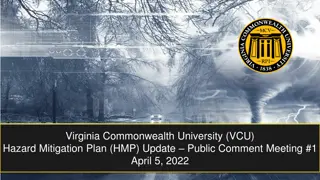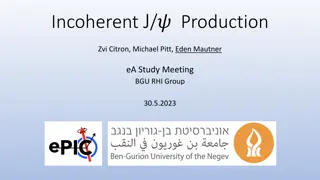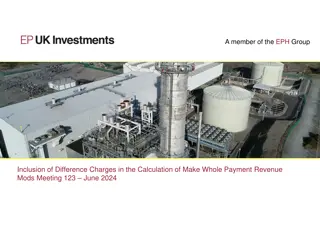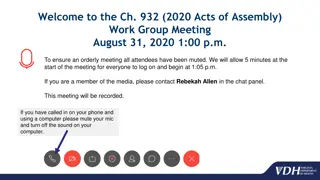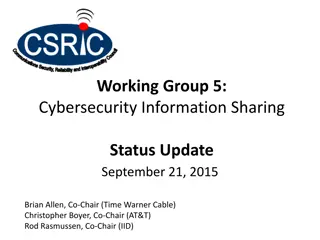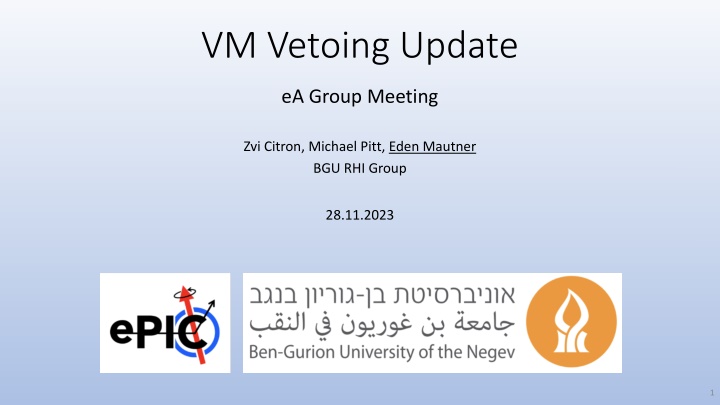
Reducing Signals in Particle Collision Events with Vetoing Algorithm
Explore the process of reducing signals from incoherent particle collision events using a vetoing algorithm. Learn about the steps involved, objectives, and results from the study. Find out how the algorithm helps identify and eliminate unwanted signals, leaving behind mainly quasi-coherent events in the data.
Download Presentation

Please find below an Image/Link to download the presentation.
The content on the website is provided AS IS for your information and personal use only. It may not be sold, licensed, or shared on other websites without obtaining consent from the author. If you encounter any issues during the download, it is possible that the publisher has removed the file from their server.
You are allowed to download the files provided on this website for personal or commercial use, subject to the condition that they are used lawfully. All files are the property of their respective owners.
The content on the website is provided AS IS for your information and personal use only. It may not be sold, licensed, or shared on other websites without obtaining consent from the author.
E N D
Presentation Transcript
VM Vetoing Update eA Group Meeting Zvi Citron, Michael Pitt, Eden Mautner BGU RHI Group 28.11.2023 1
Reminder ?/? production events can be found in eA collision, or in our case, ePb collision. Both coherent and incoherent?/? can be produced In incoherent events the proccess is in the form of ? + ?? ? + ?/? + ? In coherent events the proccess is in the form of ? + ?? ? + ?/? + ?? Incoherent Coherent 2
Past Studies (Pre-ePIC) Objective: Creating a vetoing algorithm to significantly reduce the signals from events with incoherent ?/? production in ePb collisions. This was originaly proposed for ECCE geometry: arXiv:2108.01694 Note - 1.3M events were used in arXiv:2108.01694. Vetoing Steps: Veto.1: No activity other than ? and ?/? in the main detector ??? ? ) ; ( ? < 4 and ??> 100 Veto.2: Veto.1 and no Neutron in ZDC; Veto.3: Veto.2 and no Proton in RP; Veto.4: Veto.3 and no Proton in OMDs; Veto.5: Veto.4 and no Proton in B0; Veto.6 Veto.5 and no Photon in B0; Veto.7: Veto.6 and no Photon with ? > 50 ??? in ZDC. 3
Past Studies (Pre-ePIC) Particle kinematics before vetoing: Particle kinematics after vetoing: Originaly shown in: arXiv:2108.01694 4
Vetoing Incoherent Events in ePIC Objectives: Studying vetoing cuts in incoherent ?/? production events using the up-to-date ePIC detector simulation. Data: We use BeAGLE generated events (~ 770k), starting with the ?/? ?+? decay channel. Note: This was done so we don t have to worry (for now) about the electron originating from the electron beam. Up-to-date Vetoing Steps: MeV c) ; Veto.1: No activity other than ? and ?/? ( ?+? ) in the main detector ( ? < 4 ,PT> 100 Veto.2: Veto.1 and no signal in the ZDC; Veto.3: Veto.2 and no tracks in RP; Veto.4: Veto.3 and no tracks in OMDs; Veto.5: Veto.4 and no tracks in B0 tracker; Veto.6: Veto.5 and no signal in B0 ECAL. 5
Results 1cm Beam Pipe Up-to-date Vetoing Steps: Veto.1: No activity other than ? and ?/? ( ?+? ) in the main MeV c) ; detector ( ? < 4 ,PT> 100 Veto.2: Veto.1 and no signal in the ZDC; Survived Event Ratio Veto.3: Veto.2 and no tracks in RP; Total Events 774068 100 % Veto.4: Veto.3 and no tracks in OMDs; Veto.5: Veto.4 and no tracks in B0 tracker; Veto 1 734482 ~ 94.89% Veto.6: Veto.5 and no signal in B0 ECAL. Veto 2 55349 ~ 7.15% Veto 3 4449 ~ 0.57% Veto 4 4336 ~ 0.56% Veto 5 4295 ~ 0.55% Veto 6 2514 ~ 0.32% 6
Results 1cm Beam Pipe After vetoing incoherent events we are left mainly with quasi-coherent events. Reminder - Quasi-coherent process are events where the nucleus is excited and soft photons are emitted in the deexcitation process (e + P? ? + ?? + ?/? + ??). 7
Particle kinematics before vetoing: Results 1cm Beam Pipe Particle kinematics after vetoing: 8
Results 2mm Beam Pipe Up-to-date Vetoing Steps: Veto.1: No activity other than ? and ?/? ( ?+? ) in the main No impact when changing the beam pipe width from 1cm to 2mm. MeV c) ; detector ( ? < 4 ,PT> 100 Veto.2: Veto.1 and no signal in the ZDC; Survived Event Ratio Veto.3: Veto.2 and no tracks in RP; Total Events 1212548 100 % Veto.4: Veto.3 and no tracks in OMDs; Veto.5: Veto.4 and no tracks in B0 tracker; Veto 1 1151429 ~ 94.95% Veto.6: Veto.5 and no signal in B0 ECAL. Veto 2 68759 ~ 5.67% Veto 3 6062 ~ 0.50% Veto 4 5863 ~ 0.48% Veto 5 5820 ~ 0.48% Veto 6 3271 ~ 0.27% 9
Comparison The shape of the tales starting from veto 2 forward seems different. Any ideas why? Would expect ratio of survived events to be same after veto1. This is not the case.. Up-to-date Vetoing Steps: Without beam pipe With beam pipe Veto.1: No activity other than ? and ?/? ( ?+? ) in the main detector Veto 1 86.9% Veto 1 ~ 94.89% MeV c) ; ( ? < 4 ,PT> 100 Veto 2 5.81% Veto 2 ~ 7.15% Veto.2: Veto.1 and no signal in the ZDC; Veto 3 5.81% Veto 3 ~ 0.57% Veto.3: Veto.2 and no tracks in RP; Veto 4 5.09% Veto 4 ~ 0.56% Veto 5 4.32% Veto 5 ~ 0.55% Veto.4: Veto.3 and no tracks in OMDs; Veto 6 2.29% Veto 6 ~ 0.32% Veto.5: Veto.4 and no tracks in B0 tracker; Veto 7 1.06% Veto.6: Veto.5 and no signal in B0 ECAL. 10
Comparison The shape of the tales starting from veto 2 forward seems different. Any ideas why? Would expect ratio of survived events to be same after veto1. This is not the case.. Veto 4 reduces one order of magnitude more than in past studies. When including the beam pipe there are many events that leave tracks in the OMD and RP due to showers originating from interaction with the beam pipe. Up-to-date Vetoing Steps: Without beam pipe With beam pipe Veto.1: No activity other than ? and ?/? ( ?+? ) in the main detector Veto 1 86.9% Veto 1 ~ 94.89% MeV c) ; ( ? < 4 ,PT> 100 Veto 2 5.81% Veto 2 ~ 7.15% Veto.2: Veto.1 and no signal in the ZDC; Veto 3 5.81% Veto 3 ~ 0.57% Veto.3: Veto.2 and no tracks in RP; Veto 4 5.09% Veto 4 ~ 0.56% Veto 5 4.32% Veto 5 ~ 0.55% Veto.4: Veto.3 and no tracks in OMDs; Veto 6 2.29% Veto 6 ~ 0.32% Veto.5: Veto.4 and no tracks in B0 tracker; Veto 7 1.06% Veto.6: Veto.5 and no signal in B0 ECAL. 11
Reproducing Past Results Objectives: Follow the vetoing steps as done in the past (arXiv:2108.01694) to check if the results we obtain are as expected from the paper. Understand what causes the differences between both methods. Data: We use same BeAGLE generated events (~ 770k). Vetoing Steps: Veto.1: No activity other than ? and ?/? in the main ??? ? ) ; detector ( ? < 4 and ??> 100 Veto.2: Veto.1 and no Neutron in ZDC; Veto.3: Veto.2 and no Proton in RP; Veto.4: Veto.3 and no Proton in OMDs; Veto.5: Veto.4 and no Proton in B0; Veto.6 Veto.5 and no Photon in B0; Veto.7: Veto.6 and no Photon with ? > 50 ??? in ZDC. 12
Discussion The tails of the events still have a different shape from past studies. When vetoing truth level events we see that peek of veto.4 (no proton in RP and OMD) look as we would expect from previous results. The differences between vetoing truth level events to events which were simulated through the ePIC geometry is mainly due to seconderies from the beam pipe (?). The difference in the event survive rate between past studies and truth level vetoing can be explained by the fact that we did not include the electron decay channel of the Jpsi VM. In the electron decay channel there might be more radiation effects that will contribute to total surviving rates after each veto. Truth level vetoing Without beam pipe Veto 1 81.46% Veto 1 86.9% Veto 2 8.28% Veto 2 5.81% Veto 3 + 4 6.78% Veto 3 5.81% Veto 5 6.78% Veto 4 5.09% Veto 6 1.59% Veto 5 4.32% *** Electron channel will be added soon to verify the claim. Veto 7 0.40% Veto 6 2.29% 13 Veto 7 1.06%






